基于人工源的甚低频电磁波空间传播特征统计分析
徐维东, 张学民, 李忠, 赵庶凡, 张伟
1 防灾科技学院, 河北三河 065201 2 中国地震局地震预测研究所, 北京 100036
基于人工源的甚低频电磁波空间传播特征统计分析
徐维东1, 张学民2*, 李忠1, 赵庶凡2, 张伟1
1 防灾科技学院, 河北三河065201 2 中国地震局地震预测研究所, 北京100036
摘要利用2005年1月至2010年11月DEMETER卫星记录的NWC发射站的VLF电场功率谱数据,采用指数拟合的方法,分析了VLF电磁波在卫星高度激发的电场空间分布和衰减特征.研究结果表明: (1) VLF电场在发射站上空及其磁共轭区有着很强的对应关系,存在南、北2个强电场中心涡; (2) 相对于发射站的位置,VLF电场中心点具有经度和纬度偏移,日侧地磁经度偏移均值大于夜侧,而地磁纬度偏移均值则小于夜侧; (3) 日侧VLF电场强度呈现出周期性的年变化; (4) 在VLF电场中心10°范围内,电场强度随距离快速衰减,衰减常数b在长达6年的时间内保持稳定.在以上研究结果基础上初步构建的卫星高度人工源电磁波空间分布特征,将为研究地表-电离层电磁波传播机理提供基础技术支撑.
关键词甚低频电场功率谱; 甚低频电磁波传播; DEMETER卫星; 电离层; 指数拟合
1引言
甚低频(VLF 3~30 kHz)电磁波在传播中具有衰减低、稳定性高、传播距离远等优点.目前世界上建立的地基VLF发射站超过40个,主要应用在潜艇通讯、无线电导航、地球物理勘察等领域.有关VLF电磁波的研究,过去主要是研究雷电、流星活动、γ射线等诱导甚低频信号扰动(Inan et al.,1996;Cummer,2000;Otsuyama et al.,2003;De et al.,2006).自20世纪以来,人们开展了大量的地基VLF/LF(低频)电磁波地震监测应用研究.结果表明,地震前VLF/LF电磁波在强度、相位方面出现异常扰动和相移等变化(Hayakawa et al.,1996;Molchanov et al.,1998;Rozhnoi et al.,2005;Biagi et al.,2008).
随着卫星观测技术的发展,人们发现VLF/LF电磁波不仅仅限于在地-电离层波导中传播,还可以穿透进入电离层而被低轨卫星记录到(Gokhberg et al.,1983;Molchanov,1991),这对地震电磁辐射在电离层传播研究具有非常好的参考价值(Hayakawa et al.,1993;Parrot et al.,2009).
越来越多的卫星观测证明了电离层电磁场扰动与地震相关性的存在.Cerisier等(1985)利用Aureol-3(408 km)卫星观测到高纬电离层F区电子密度和电场的异常扰动.Parrot和Mogilevsky(1989)对Aureol-3(408 km)卫星数据分析后发现地震引起电离层极低频电磁波异常辐射.Intercosmos-Bulgaria-1300(825 km)卫星观测到地震前15 min水平磁场分量变化幅度达3 nT(Chmyrev et al.,1989).Serebryakova等(1992)对COSMOS-1809(970 km)卫星记录的信号进行分析后,发现在震区上空发生强烈的极低频辐射.Molchanov等(1993)对Intercosmos-24(511 km)卫星数据进行分析后发现地震前12~14 h,震区上空超低频和极低频辐射都达到最大值.
近年来,多个研究者利用卫星观测的地面发射站的VLF电磁波信号来研究其与地震活动的关系.Molchanov等(2006)分析了DEMETER卫星接收FTU发射站(18.3 kHz,法国)和DFY发射站(16.56 kHz,德国)的VLF信号,发现在地震发生前一段时间VLF波信号信噪比一直在降低;Rozhnoi等(2007,2010)分别利用俄罗斯堪察加半岛的接收站和DEMETER卫星来接收JJY发射站(40 kHz,日本)、JJI发射站(22.2 kHz,日本)、NWC发射站(19.8 kHz,澳大利亚)、NPM发射站(21.4 kHz,夏威夷群岛)的VLF信号,分析了信号振幅和相位的异常与地震的关系.地基与天基VLF电磁波观测都是独立的,信号来源可知且一致,因此天地联合对比分析提高了地震扰动判识的可靠性.
以上研究利用天基电磁波观测数据分析了地震电磁辐射引起的异常扰动现象,但并没有分析在卫星高度电磁波正常的传播特性及其时空演化特征.本文收集2005—2010年法国DEMETER卫星记录的NWC发射站VLF信号数据,利用插值、拟合等数据处理方法,统计分析了人工源VLF信号在空间的时空分布与衰减特征.研究结果可为认识空间电磁背景场提供理论支撑.
2数据选取
2.1DEMETER卫星
卫星对地观测提供了一个从地面发射站发射信号来研究卫星高度空间电磁波传播特性的机会.DEMETER卫星(Cussac et al.,2006)于2004年6月发射,其主要科学任务是研究与地震活动相关的电离层扰动.卫星在轨期间记录到了多次地震异常现象(Parrot et al.,2006;张学民等,2009,2010;刘静等,2011;泽仁志玛等,2012).DEMETER卫星采用近圆形太阳同步轨道,一条完整的轨道分为升轨和降轨,升轨是指卫星从南纬飞向北纬的轨道,对应磁地方时MLT22∶30;降轨是指卫星从北纬飞向南纬的轨道,对应磁地方时MLT 10∶30.卫星倾角为98°,卫星高度最初为710 km,2005年11月调整为660 km.卫星每天运行14个轨道,相邻轨道相距约24°,重访周期为16天,其工作区间在北纬65°至南纬65°.该卫星有两种工作模式:加密模式和巡查模式(Berthelier et al.,2006).卫星经过全球地震活动带上空时采用高采样率加密模式,其他区域采用巡查模式进行观测.卫星携带的科学荷载有:电场测量仪(ICE)、磁场测量仪(IMSC)、等离子体分析仪(IAP)、高能粒子探测仪(IDP)、朗缪尔探针(ISL).本文研究对象是电场测量仪测量的VLF频段电场数据,垂直于卫星轨道面电场分量(E12)功率谱是在卫星上计算的,采样分辨率为19.5 Hz,频率范围是19.5 Hz~20 kHz,时间分辨率为2 s.
2.2NWC发射站
NWC发射站(21°48′59″S、114°09′56″E)位于澳大利亚西北海岸,该无线电发射站为部署在西太平洋和东印度洋的美国海军和澳大利亚皇家海军的战舰和潜艇提供(VLF)无线电通信.VLF波的发射频率是19.8 kHz,发射功率是1 MW,是南半球功率最大的无线电传输站.本文只考虑电场的测量数据,故采用DEMETER卫星记录(2005—2010年)来自澳大利亚NWC发射站发射的19.8 kHz处的电场功率谱密度数据.
3结果分析
3.1VLF电场空间分布
我们首先收集2005年1月—2010年11月DEMETER卫星接收NWC发射站的信号,提取该卫星在19.8 kHz处的电场强度数据,并采用空间插值法计算其地理坐标、地磁坐标、世界时等参数.图1给出了2006年1月夜侧(升轨)VLF电场功率谱密度全球分布,图中横坐标是地磁经度,纵坐标是地磁纬度,色标是电场强度,颜色从蓝到红的变化代表场强的逐渐变大,图中黑色五角星代表NWC发射站在地磁坐标的空间投影位置.
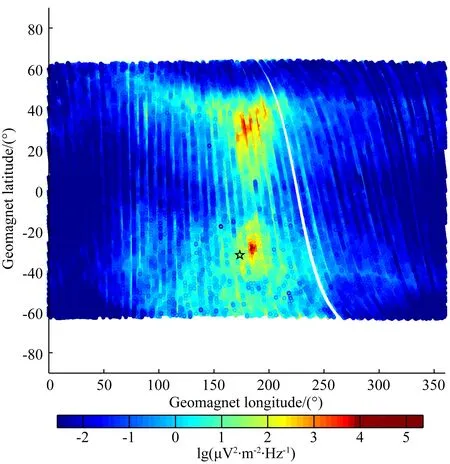
图1 2006年1月19.8 kHz VLF电场功率谱全球分布图(夜侧)Fig.1 The global spatial distribution of VLF electric field spectrogram at 19.8 kHz in January 2006 (nightside)
从图1看出,VLF电场在南半球的工作站上空与北半球的磁共轭区有着很强的对应关系,存在南、北2个强电场中心涡,辐射主要沿纬度方向扩展.南半球的VLF电场大致分布在赤道与南纬60°、经度120°—240°.在南纬15°—40°内存在一个强电场中心涡,场强较大且呈近似圆环的分布,Lehtinen和Inan(2009)认为这是由地球-电离层波导中的VLF波导模式的干扰所致.VLF电场向南辐射的范围逐渐增大,场强也随之减小.北半球的VLF电场覆盖范围从赤道延伸到北纬50°附近,经度在100°—240°.电场中心涡覆盖范围在北纬20°—40°,经度在170°—210°.VLF电场场强从低纬度到高纬度逐渐增大,在北纬20°—40°范围内场强到达最大值,而在北纬50°附近电场沿磁壳指数L线分布,在北纬50°以上场强迅速减小.
3.2VLF电场中心点坐标变化
为保证统计结果的有效性,本文选择VLF电场场强最大值所在位置的10°范围(1000 km)作为研究区域.在计算VLF电场中心点坐标时,采用VLF电场强度前20位最大值的地磁经纬度均值作为电场中心点坐标.分别提取2005年1月到2010年11月日侧和夜侧的VLF电场数据,利用插值法和中值法计算出日侧、夜侧VLF电场中心点地磁坐标,然后引用国际地磁参考模型(IGRF11),计算出2005—2010年NWC发射站的地磁坐标,再用VLF电场中心点地磁坐标与NWC站点地磁坐标作差值计算,就得到日侧、夜侧VLF电场中心点相对发射站地磁经纬度的偏移量,其计算结果分别如图2和图3所示.由于2005年12月数据缺失严重,2007年6月至2008年1月NWC发射站关闭,故此期间的数据做缺值处理.图2和图3中,居上的曲线是地磁经度偏移值,居下的曲线是地磁纬度偏移值.
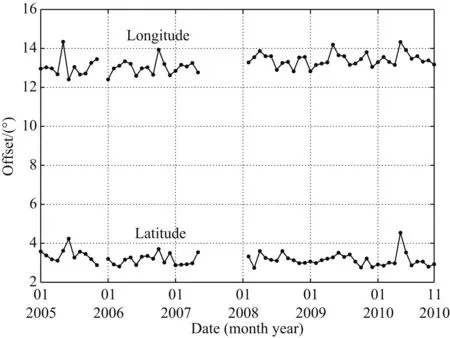
图2 VLF电场中心点相对NWC发射站的地磁经纬度偏移(日侧)Fig.2 The offset of geomagnetic coordinate of VLF electric field related to NWC station (dayside)
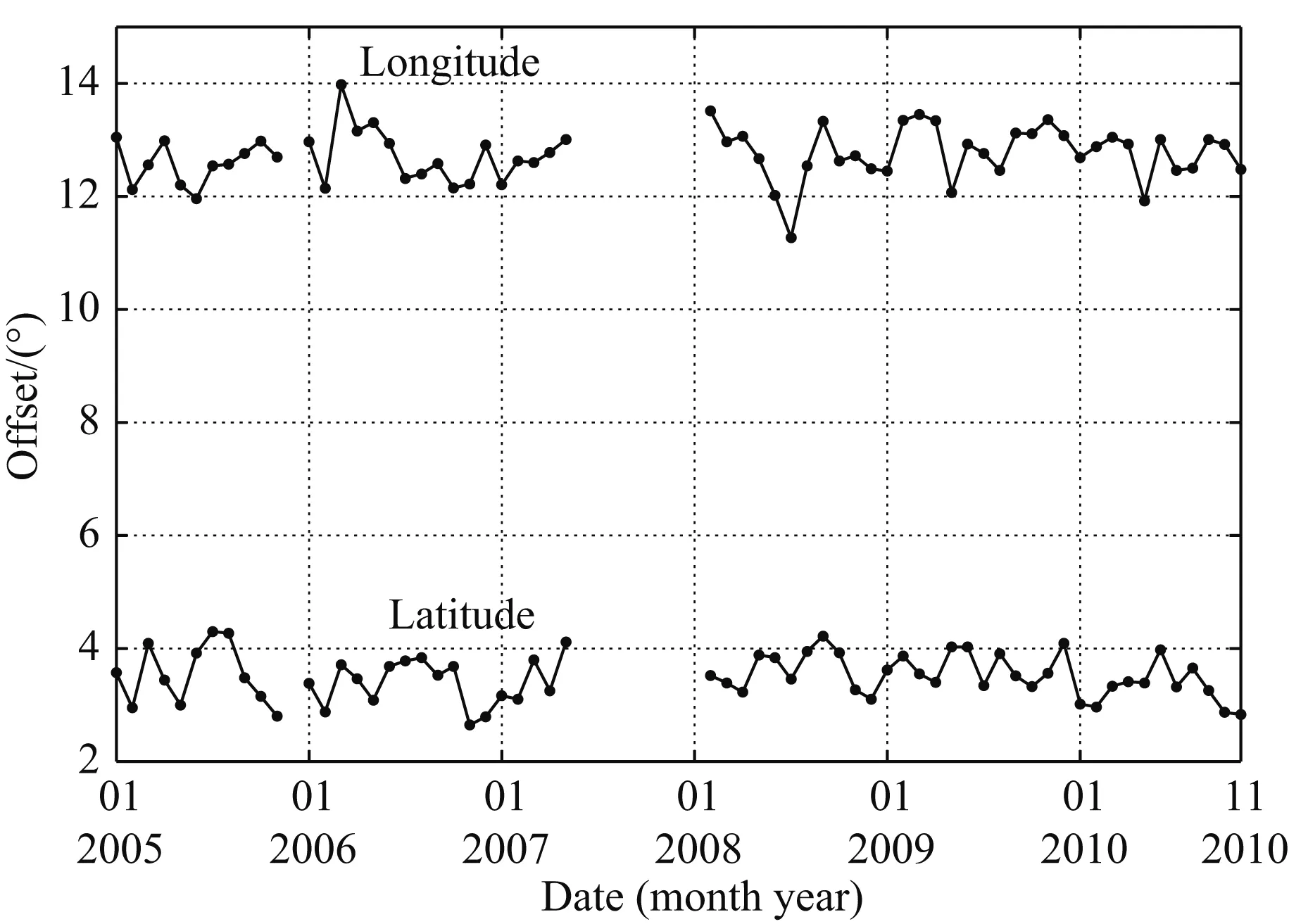
图3 VLF电场中心点坐标相对NWC发射站点的地磁经纬度偏移(夜侧)Fig.3 The offset of geomagnetic coordinate of VLF electric field related to NWC station (nightside)
从图2和图3不难看出,日侧和夜侧VLF电场中心点地磁坐标相对NWC发射站都发生了偏移.Pulinets和Ouzounov(2011)认为偏移是由于电磁波沿着磁力线传播的缘故.在日侧,地磁经度偏移均值是13.24°,最大值是14.34°,最小值是12.41°,二者相差1.93°;地磁纬度偏移的均值是3.20°,最大值是4.54°,最小值是2.73°,二者相差1.81°.在夜侧,地磁经度偏移的均值是12.73°,最大值是13.98°,最小值是11.27°,二者相差2.71°;地磁纬度偏移的均值是3.50°,最大值是4.30°,最小值是2.65°,二者相差1.65°.地磁纬度偏移是由于VLF电磁波群速度的方向所致(Lehtinen and Inan,2009).VLF电场中心点偏移的范围(经向12°~14°,纬向2°~5°)与前人研究(Henderson et al.,1993;Němec F et al.,2009)电离层扰动所选的影响范围(经向±6°/±10°,纬向±2°/±5°)大致相同.比较日侧和夜侧的VLF电场中心点偏移量,日侧地磁经度偏移均值大于夜侧,而地磁纬度偏移均值则小于夜侧,这可能与日侧电离层比夜侧电离层所受太阳辐射的影响大有关.
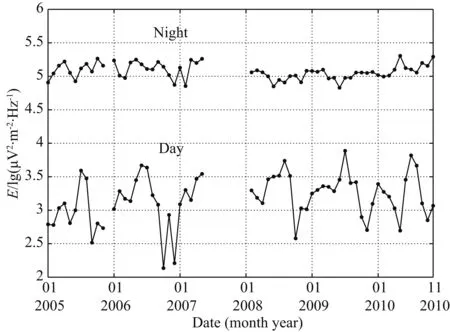
图4 2005—2010年VLF电场中心点功率谱强度变化Fig.4 Changes of PSD intensity in electric field at VLF center from 2005 to 2010
3.3VLF电场中心点强度随时间变化
采用VLF电场强度前20位最大值的均值作为VLF电场中心点强度,分月计算出日侧和夜侧VLF电场中心点强度,计算结果如图4所示.图4中居上的曲线是2005年1月至2010年11月夜侧VLF电场中心点强度变化,居下的曲线是2005年1月至2010年11月日侧VLF电场中心点强度变化,图中横坐标是时间,纵坐标是电场功率谱强度.
通过图4分析得出:日侧,每年VLF电场都存在一个峰值,其出现的月份集中在6、7、8月,在年变趋势上呈现出周期性的变化,电场强度最大值是3.89 μV2·m-2·Hz-1(2009年7月),最小值是2.14 μV2·m-2·Hz-1(2006年10月),均值是3.18 μV2·m-2·Hz-1.夜侧,VLF电场强度最大值是5.31 μV2·m-2·Hz-1(2010年5月),最小值是4.83 μV2·m-2·Hz-1(2009年6月),均值是5.07 μV2·m-2·Hz-1.夜侧VLF电场的均值比日侧的大1.89 μV2·m-2·Hz-1,这可能与夜侧电离层受太阳辐射较少而减少电离层吸收电磁波的能量有关.3.4VLF电场中心点强度随距离变化
VLF电磁波在电离层传播过程由于低电离层的反射和等离子体碰撞吸收会产生能量的衰减(Bell and Ngo,1990;Lehtinen and Inan,2009;赵庶凡等,2011).以往的研究使用已知功率的发射站,利用卫星观测和地面观测的电磁波对比来确定电离层电磁波传播系数(Chapman et al.,1966;Tomko and Hepner,2001).Devi等(2008)通过地-电离层波导模式分析了甚低频(16 kHz)电磁波长距离(8 Mm)的传播特性.本文利用卫星观测的VLF(19.8 kHz)电磁波,采用指数函数(y=aeb x)拟合的方法来分析VLF电磁波在空间的衰减特性.考虑到VLF电场中心点的分布特征,采用每一年VLF电场中心点强度前20位最大值的均值作为该年VLF电场中心点的场强,前20位最大值所对应坐标的均值作为该年VLF电场中心点坐标,VLF电场(南半球)中心10°(1000 km)作为研究范围.VLF电场10°范围内测点随距离的分布如图5所示(以2005年为例),利用指数函数(y=aeb x)拟合测点随距离的分布如图6所示.
图5给出了VLF电场10°范围内测点随距离的分布,散点代表VLF电场中心点10°范围内的测点,横坐标是测点距VLF电场中心的距离,纵坐标是测点的电场强度.图6是利用指数函数(y=aeb x)对图5中测点的特征曲线进行拟合的结果.图中空心点线是对测点进行局部加权回归散点平滑处理后的特征曲线,细线是用指数函数对特征曲线进行拟合的线.2005—2010年VLF电场场强衰减指数拟合的相关参数统计结果见表1.
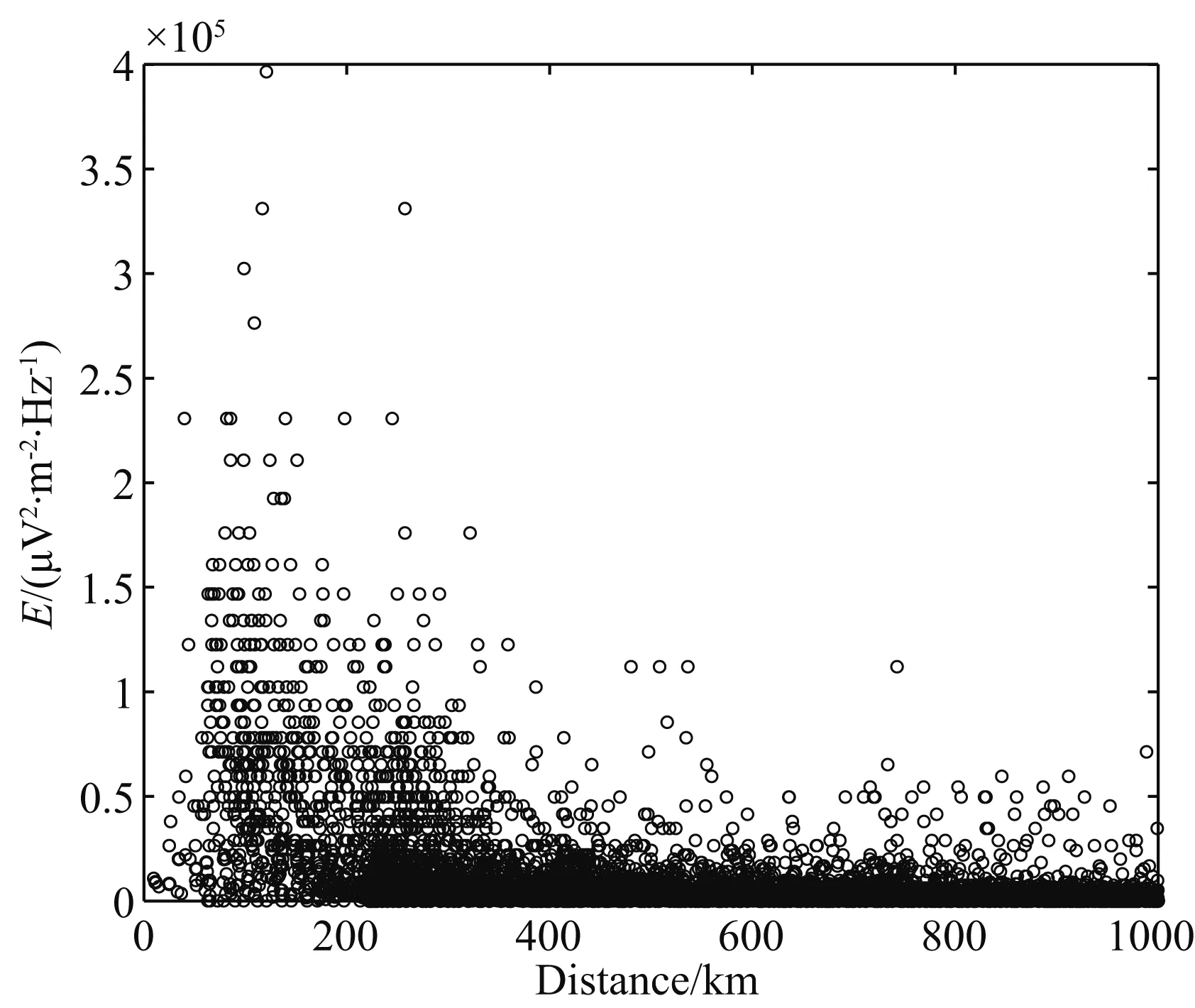
图5 VLF电场10°范围内测点电场强度随距离的分布Fig.5 The distribution of VLF electric field intensity at all observing points with the distance in the 10 degrees range
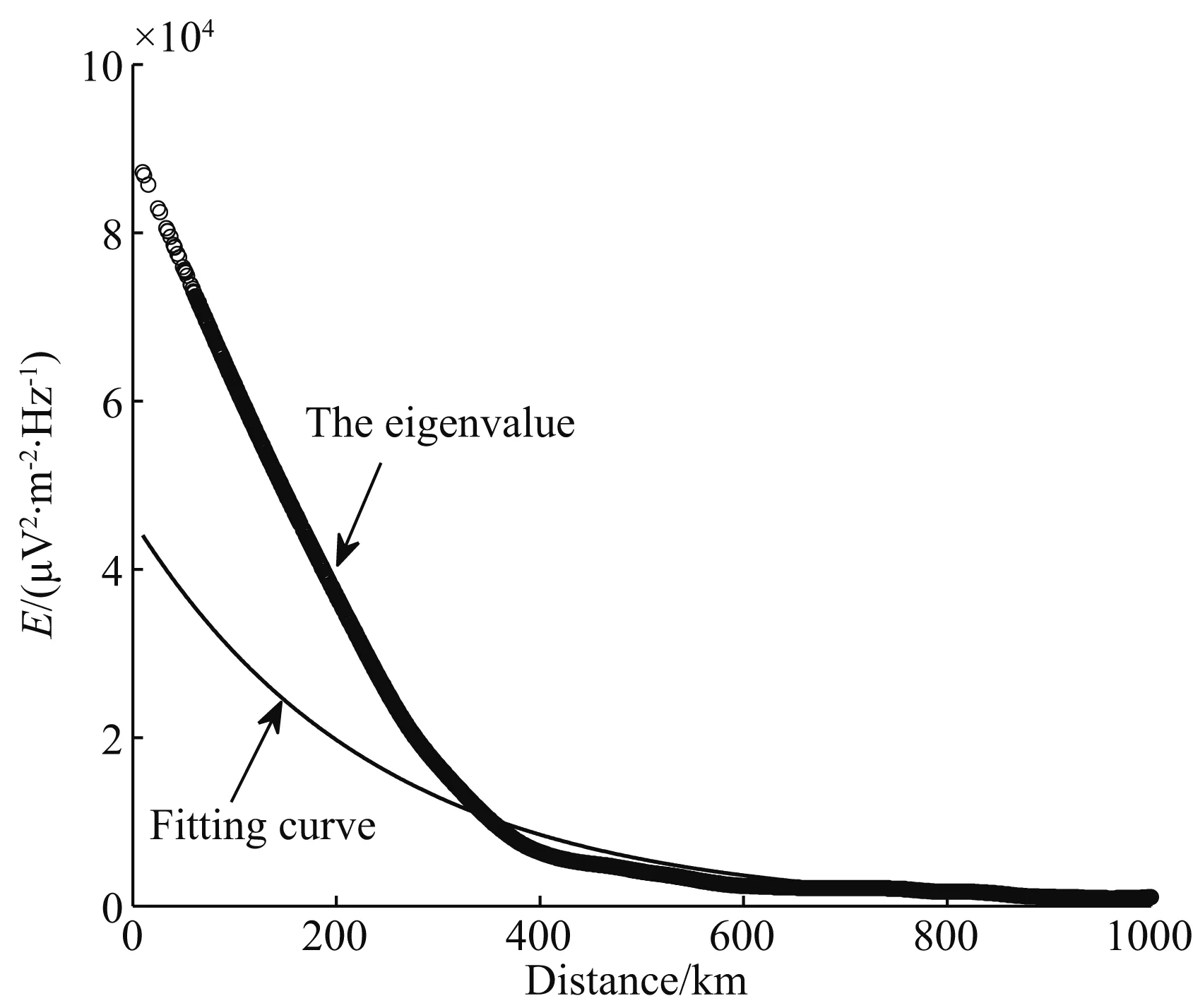
图6 利用指数函数对特征值进行拟合Fig.6 The exponential function is used to fit the eigenvalue

表1 2005—2010年电场衰减拟合参数
从指数函数的性质来看,b值是指数函数变化速率的决定因素.从表1不难看出,衰减系数b值保持在一个平稳变化的过程中,最大值为-0.00422,最小值为-0.00466,二者差值仅为-0.00044,也就是说2005—2010年VLF电场场强衰减速率稳定.参数a代表着卫星所在空间还存在着与人工电磁辐射无关的空间甚低频电磁辐射的背景.它包含着来自卫星上方磁层的甚低频辐射和来自下方地面闪电产生的电磁辐射(Inan et al.,1996;Cao et al.,2005;Wei et al.,2007;Yang et al.,2008;Parrot et al.,2009;Zeren et al.,2013,2014).
4结论与讨论
本文利用DEMETER卫星观测的NWC发射站VLF频段电场功率谱密度数据,对VLF电磁波的空间传播特征进行了统计分析.研究结果概括如下:
(1) VLF电场在南半球的工作站上空及其磁共轭区有着很强的对应关系,存在南、北2个强电场中心涡.南半球VLF电场中心涡场强较大且呈近似圆环分布,向南辐射的范围逐渐增大.磁共轭区VLF电场中心涡覆盖范围从北纬20°延伸到北纬40°.电场场强从低纬度到高纬度逐渐增大,在北纬20°—40°范围内场强到达最大值,而在北纬50°附近电场沿磁壳指数L线分布.
(2) 日侧和夜侧VLF电场中心点地磁坐标相对地面发射站NWC的地磁坐标都发生了偏移.日侧地磁经度偏移均值大于夜侧地磁经度偏移均值,而地磁纬度偏移均值则小于夜侧,这与日侧轨道比夜侧轨道所受太阳辐射的影响大有关,而地磁纬度偏移则是由于VLF电磁波群速度的方向所致.
(3) 日侧,每年VLF电场都存在一个峰值,其出现的月份集中在6、7、8月,并呈现出周期性的年变化.夜侧场强均值比日侧的大1.89 μV2·m-2·Hz-1,这可能与夜侧电离层受太阳辐射较少而减少电离层吸收电磁波的能量有关.
(4) 利用指数函数来拟合VLF电场场强衰减特性,2005—2010年衰减常数b保持在一个平稳变化的过程中,VLF电场衰减速率基本稳定.
本文在分析研究时只考虑了NWC发射站的VLF频段数据,接下来将考虑多个站点的VLF频段数据来进行对比研究,同时对VLF电场强度衰减进行定量的分析,为进一步了解VLF电磁波在空间的传播特征奠定基础.
致谢感谢法国DEMETER卫星数据中心提供数据下载服务,感谢审稿专家和编辑部对此研究工作提出的修改建议.
References
Bell T F, Ngo H D. 1990. Electrostatic lower hybrid waves excited by electromagnetic whistler mode waves scattering from planar magnetic-field-aligned plasma density irregularities.JournalofGeophysicalResearch:SpacePhysics, 95(A1): 149-172.
Berthelier J J, Godefroy M, Leblanc F, et al. 2006. ICE, the electric field experiment on DEMETER.PlanetaryandSpaceScience, 54(5): 456-471.
Biagi P F, Castellana L, Maggipinto T, et al. 2008. Disturbances in a VLF radio signal prior theM=4.7 offshore Anzio (central Italy) earthquake on 22 August 2005.NaturalHazardsandEarthSystemScience, 8(5): 1041-1048.
Cao J B, Liu Z X, Yang J Y, et al. 2005. First results of low frequency electromagnetic wave detector of TC-2/Double Star program.AnnalesGeophysicae, 23(8): 2803-2811.
Cerisier J C, Berthelier J J, Beghin C. 1985. Unstable density gradients in the high-latitude ionosphere.RadioScience, 20(4): 755-761.
Chapman F W, Jones D L, Todd J D W, et al. 1966. Observations on the propagation constant of the Earthionosphere waveguide in the frequency band 8 c/s to 16 kc/s.RadioSci., 1(11): 1273-1282.
Chmyrev V M, Isaev N V, Bilichenko S V, et al. 1989. Observation by space-borne detectors of electric fields and hydromagnetic waves in the ionosphere over an earthquake centre.Phys.EarthPlanet.Inter., 57(1-2): 110-114.
Cummer S A. 2000. Modeling electromagnetic propagation in the Earth-ionosphere waveguide.IEEETransactionsonAntennasandPropagation, 48(9): 1420-1429.
Cussac T, Clair M A, Ultré-Guerard P, et al. 2006. The DEMETER microsatellite and ground segment.PlanetaryandSpaceScience, 54(5): 413-427.
De S S, De B K, Guha A, et al. 2006. Detection of 2004 Leonid meteor shower by observing its effects on VLF transmission.IndianJ.RadioSpacePhys., 35: 396-400.
Devi M I, Khan I, Rao D N M. 2008. A study of VLF wave propagation characteristics in the earth-ionosphere waveguide.Earth,PlanetsandSpace, 60(7): 737-741.
Gokhberg M B, Pilipenko V A, Pokhotelov O A. 1983. Seismic precursors in the ionosphere.IzvestiyaEarthPhysics, 19(10): 762-765.
Hayakawa M, Yoshino T, Morgounov V A. 1993. On the possible influence of seismic activity on the propagation of magnetospheric whistlers at low latitudes.PhysicsoftheEarthandPlanetaryInteriors, 77(1-2): 97-108.
Hayakawa M, Molchanov O A, Ondoh T, et al. 1996. The precursory signature effect of the Kobe earthquake on VLF subionospheric signals.J.Comm.Res.Lab., 43: 413-418.
Henderson T R, Sonwalkar V S, Helliwell R A, et al. 1993. A search for ELF/VLF emissions induced by earthquakes as observed in the ionosphere by the DE 2 satellite.JournalofGeophysicalResearch:SpacePhysics, 98(A6): 9503-9514.
Inan U S, Slingeland A, Pasko V P, et al. 1996. VLF and LF signatures of mesospheric/lower ionospheric response to lightning discharges.J.Geophys.Res., 101(A3): 5219-5238. Lehtinen N G, Inan U S. 2009. Full-wave modeling of transionospheric propagation of VLF waves.GeophysicalResearchLetters, 36(3):151-157. Liu J, Wan W X, Huang J P, et al. 2011. Electron density perturbation before ChileM8.8 earthquake.ChineseJ.Geophys. (in Chinese), 54(11): 2717-2725, doi: 10.3969/j.issn.0001-5733.2011.11.001.Molchanov O A. 1991. Transmission of electromagnetic fields from seismic sources to the upper ionosphere.Geomagn.Aeron., 31(1): 80-85.
Molchanov O A, Mazhaeva O A, Golyavin A N, et al. 1993. Observation by the Intercosmos-24 satellite of ELF-VLF electromagnetic emissions associated with earthquakes.AnnalesGeophysicae, 11(5): 431-440.
Molchanov O A, Hayakawa M, Oudoh T, et al. 1998. Precursory effects in the subionospheric VLF signals for the Kobe earthquake.PhysicsoftheEarthandPlanetaryInteriors, 105(3-4): 239-248.Molchanov O, Rozhnoi A, Solovieva M, et al. 2006. Global diagnostics of the ionospheric perturbations related to the seismic activity using the VLF radio signals collected on the DEMETER satellite.NaturalHazardsandEarthSystemScience, 6(5): 745-753.
Němec F, Santolík O, Parrot M. 2009. Decrease of intensity of ELF/VLF waves observed in the upper ionosphere close to earthquakes: A statistical study.JournalofGeophysicalResearch:SpacePhysics, 114(A4): A04303, doi: 10.1029/2008JA013972.
Otsuyama T, Sakuma D, Hayakawa M. 2003. FDTD analysis of ELF wave propagation and Schumann resonances for a subionospheric waveguide model.RadioScience, 38(6):1103,doi:10.1029/2002RS002752, 2003.
Parrot M, Mogilevsky M M. 1989. VLF emissions associated with earthquakes and observed in the ionosphere and the magnetosphere.PhysicsoftheEarthandPlanetaryInteriors, 57(1-2): 86-99.
Parrot M, Berthelier J J, Lebreton J P, et al. 2006. Examples of unusual ionospheric observations made by the DEMETER satellite over seismic regions.PhysicsandChemistryoftheEarth,PartsA/B/C, 31(4-9): 486-495.
Parrot M, Inan U S, Lehtinen N G, et al. 2009. Penetration of lightning MF signals to the upper ionosphere over VLF ground-based transmitters.JournalofGeophysicalResearch:SpacePhysics, 114(A12):175-182.Pulinets S, Ouzounov D. 2011. Lithosphere-Atmosphere-Ionosphere Coupling (LAIC) model—An unified concept for earthquake precursors validation.JournalofAsianEarthSciences, 41(4-5): 371-382.Rozhnoi A A, Solovieva M S, Molchanov O A, et al. 2005. Anomalies of LF signal during seismic activity in November-December 2004.NaturalHazardsandEarthSystemScience, 5(5): 657-660.
Rozhnoi A, Molchanov O, Solovieva M, et al. 2007. Possible seismo-ionosphere perturbations revealed by VLF signals collected on ground and on a satellite.NaturalHazardsandEarthSystemScience, 7(5): 617-624.
Rozhnoi A, Solovieva M, Molchanov O, et al. 2010. Variations of VLF/LF signals observed on the ground and satellite during a seismic activity in Japan region in May-June 2008.NaturalHazardsandEarthSystemScience, 10(3): 529-534.
Serebryakova O N, Bilichenko S V, Chmyrev V M, et al. 1992. Electromagnetic ELF radiation from earthquake regions as observed by low-altitude satellites.GeophysicalResearchLetters, 19(2): 91-94.Tomko A A, Hepner T. 2001. Worldwide monitoring of VLF-LF propagation and atmospheric noise.RadioSci., 36(2): 363-369.
Wei X H, Cao J B, Zhou G C, et al. 2007. Cluster observations of waves in the whistler frequency range associated with magnetic reconnection in the Earth′s magnetotail.J.Geophys.Res., 112: A10225, doi: 10.1029/2006JA011771.
Yang J Y, Cao J B, Yan C X, et al. 2008. The mid-high latitude whistler mode chorus waves observed around substorm onsets.ScienceinChinaSeriesE:TechnologicalSciences, 51(10):
1648-1658.
Zeren Z M, Shen X H, Cao J B, et al. 2012. Statistical analysis of ELF/VLF magnetic field disturbances before major earthquakes.ChineseJ.Geophys. (in Chinese), 55(11): 3699-3708, doi: 10.6038/j.issn.0001-5733.2012.11.017.Zeren Z M, Cao J B, Liu W L, et al. 2013. DEMETER observations of high-latitude chorus waves penetrating the plasmasphere during a geomagnetic storm.Geophys.Res.Lett., 40(22): 5827-5832, doi: 10.1002/2013GL058089.
Zeren Z M, Cao J B, Liu W L, et al. 2014. Storm time evolution of ELF/VLF waves observed by DEMETER satellite.JournalofGeophysicalResearch, 119(4): 2612-2622, doi: 10.1002/2013JA019237.
Zhang X M, Shen X H, Ouyang X Y, et al. 2009. Ionosphere VLF electric field anomalies before WenchuanM8 earthquake.ChineseJournalofRadioScience(in Chinese), 24(6): 1024-1032.
Zhang X M, Liu J, Shen X H, et al. 2010. Ionospheric perturbations associated with theM8.6 Sumatra earthquake on 28 March 2005.ChineseJ.Geophys. (in Chinese), 53(3): 567-575, doi: 10.3969/j.issn.0001-5733.2010.03.010.
Zhao S F, Shen X H, Pan W Y, et al. 2011. Penetration characteristics of VLF wave from atmosphere into the lower ionosphere.ChineseJ.SpaceSci. (in Chinese), 31(2): 194-200.
附中文参考文献
刘静, 万卫星, 黄建平等. 2011. 智利8.8级地震的震前电子浓度扰动. 地球物理学报, 54(11): 2717-2725, doi: 10.3969/j.issn.0001-5733.2011.11.001.
泽仁志玛, 申旭辉, 曹晋滨等. 2012. 强震前ELF/VLF磁场的扰动特征统计研究. 地球物理学报, 55(11): 3699-3708, doi: 10.6038/j.issn.0001-5733.2012.11.017.
张学民, 申旭辉, 欧阳新艳等. 2009. 汶川8级地震前空间电离层VLF电场异常现象. 电波科学学报, 24(6): 1024-1032.
张学民, 刘静, 申旭辉等. 2010. 2005年3月28日苏门答腊8.6级地震前的电离层扰动. 地球物理学报, 53(3): 567-575, doi: 10.3969/j.issn.0001-5733.2010.03.010.
赵庶凡, 申旭辉, 潘威炎等. 2011. VLF波从大气层到低电离层的传输特性分析. 空间科学学报, 31(2): 194-200.
(本文编辑胡素芳)
Statistical analysis of the propagation characteristics of VLF electromagnetic waves excited by the artificial transmitter
XU Wei-Dong1, ZHANG Xue-Min2*, LI Zhong1, ZHAO Shu-Fan2, ZHANG Wei1
1InstituteofDisasterPrevention,SanheHebei065201,China2InstituteofEarthquakeScience,ChinaEarthquakeAdministration,Beijing100036,China
AbstractBased on the data collection in VLF electric field power spectral density (PSD) recorded by DEMETER satellite during January 2005 to November 2011, the spatial distribution and attenuation features in electric field at topside ionosphere excited by NWC transmitter has been analyzed by using exponential fitting method.It is found that: (1) The VLF electric field exhibits strong relations in the ionosphere over the transmitter and its magnetic conjugate area, presenting two electric field vortex centers at southern and northern hemisphere respectively; (2) The longitude and latitude of VLF electric field center in ionosphere has an offset to the actual location of the transmitter, in which the averaged longitudinal deviationat dayside is greater than that at nightside, while the latitudinal deviation at dayside is less than that at nightside; (3) The annual periodis revealed in dayside VLF electric field intensity variations; (4) Within 10°scale around the VLF electric field center, the electric field intensity decreases quickly with the increase of distance, and the averaged fitted coefficient b values is steady in six years. The preliminary results in the space distribution characteristics at satellite altitude excited by the artificial VLF transmitter will provide basic technical support for the electromagnetic wave propagation mechanism from ground into the ionosphere.
KeywordsVLF electric power spectral; VLF radio wave propagation; DEMETER satellite; Ionosphere; Exponential fitting
基金项目科技部国际科技合作项目(2014DFR21280),中央高校基本科研业务费研究生科技创新基金(ZY20150309)联合资助.
作者简介徐维东,男,1981年生,硕士研究生,主要从事地震电磁卫星数据分析研究.E-mail:x_weidong@163.com *通讯作者张学民,女,1969年生,中国地震局地震预测研究所研究员,主要从事地震电磁卫星研究.E-mail:zhangxm96@126.com
doi:10.6038/cjg20160503 中图分类号P352
收稿日期2015-05-22,2015-12-15收修定稿
徐维东, 张学民, 李忠等. 2016. 基于人工源的甚低频电磁波空间传播特征统计分析.地球物理学报,59(5):1578-1584,doi:10.6038/cjg20160503.
Xu W D, Zhang X M, Li Z, et al. 2016. Statistical analysis of the propagation characteristics of VLF electromagnetic waves excited by the artificial transmitter.ChineseJ.Geophys. (in Chinese),59(5):1578-1584,doi:10.6038/cjg20160503.

